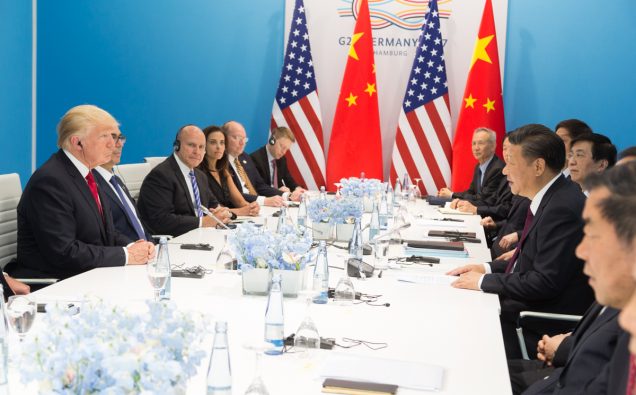
President Donald Trump and Chinese counterpart Xi Jinping at G-20 meeting in July 2017, Photo Credit: The White House/Wikimedia Commons
The U.S.-China trade war which saw Beijing impose $3 billion in tariff on 128 American products in its first reaction to Washington’s intent to levy $ 60 billion tariff on steel and aluminum, will impact both consumers and industries.
Since the two largest economies are interdependent for growth in wide-ranging areas, consumers and industries in both countries might feel the pinch if prices of things go up.
For instance, American consumers may have to pay higher costs if the U.S. imposes tariffs on imports from China including items of everyday use like TV, cell phones, computers and even sneakers. The U.S. buys Chinese electrical machinery and equipment worth $ 146 billion each year.
On the other side, Beijing’s decision to tax import of 128 products from the United States including fruits and meat like apples, oranges, almonds, pineapples, pork, grapes, watermelons, strawberries, and cherries – will likely raise prices of these food items for Chinese consumers.
According to the National Pork Producers Council, the U.S. exported $1.1 billion in pork to China in 2017.
In the worst-case scenario, both countries could reduce or do away with bilateral trade in high-tariff items and explore other markets in such regions as Asia, Europe and Latin America.
That would have implications for producers and manufacturers in both the United States and China. The two countries had a $ 640 billion two-way trade in 2017 – with Beijing sending $ 505 billion in products to the U.S. and American companies selling $ 135 billion in goods to China. In the event, the cost of production goes up, it will have effects across the wider spectrum.
For example, China imports Boeing planes worth billions of dollars and experts say new steel tariffs could put a premium on manufacturing. Citing a report by a trade consulting firm, the CNN recently reported that industries using steel and aluminum, could cut down nearly 100,000 jobs due to the tariffs.
The Trump Administration has so far brushed aside the threat of any drastic ramifications resulting from its trade measures, arguing the U.S.-China trade gap needs to be fixed. Besides, American businesses have alleged that China violates intellectual property rights and also resorts to currency manipulation to support the country’s exporters.
As noted by The Washington Post, President Trump has alleged that China’s trade practices have caused a closure of 60,000 factories and the loss of 6 million jobs.
But the overriding concerns for the U.S.-China trade is not confined just to two-way commerce. It could hit the international scenario.
There could be other implications like China not buying U.S. debt, a factor that keeps interest rates low.
Some analysts also say the United States continues to enjoy an impressive economic growth rate with the recent update recording the gross domestic product increase to 2.9 % in the last three quarters of 2017 and, therefore the world’s largest economy is in a position to absorb trade adjustments.
A key measure to understand the impact of China’s move to impose tariffs on U.S. imports could also be reflected in the international financial markets’ response to the development during this week.














